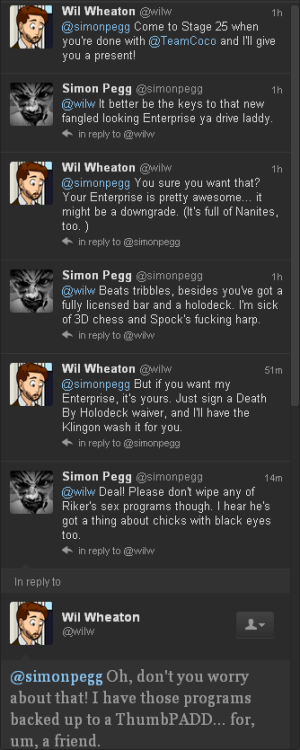The Metro Developer Show is the first podcast exclusively for Metro developers and enthusiasts.
Each week Ryan and Travis Lowdermilk traverse the exciting world of Metro (phone, tablet, desktop and Xbox); covering the latest news and exploring what it means for the developer community and everyday users.
Web app for making diagrams like Visio. Export your results as SVG, PNG, PDF and others.
A House subcommittee has passed the Global Online Freedom Act (GOFA), which would require disclosure from companies about their human rights practices and limit the export of technologies that “serve the primary purpose of” facilitating government surveillance or censorship to countries designated as “Internet-restricting.”
Another Comedy Bang Bang preview clip this time with Zach Galifianakis.
Javascript tool says if a photo is shopped. It can tell by looking at the pixels. Seriously. Links to cool presentation on the theory behind the algorithm behind the tool: http://www.wired.com/images_blogs/threatlevel/files/bh-usa-07-krawetz.pdf
Primer - Full Movie (by mvjstrikesagain).
This movie is great. There’s really no excuse now - Primer is on YouTube for free. Best representation and exploration of time travel in a movie.
“On The Verge is ready for a lot of things, but we clearly weren’t ready for renowned astrophysicist Dr. Neil deGrasse Tyson, who stopped by to talk space exploration, life as a meme, and why he carries a slightly-illegal laser with him at all times.”
Intro to the world of the 0day exploit market.

You guys, the cast of every single iteration of Star Trek is the best cast ever.
Trufax.
I still can’t believe that this is a real thing that happened.
Astronaut endorses destroying the moon!
The best exchange on the IAmA:
Ghostshirts it’s been a dream for a long time now, do you think that we’ll actually be able to blow up the moon in our lifetime?
RonGaran I truly believe that we can accomplish anything we set our minds on. We only need the will to do it
Do we have a word or phrase to describe the following situation: You code up something complicated and it compiles and works on the first try. You then spend the next ten minutes trying to figure out what's actually broken because it shouldn't be this easy.
Is this really the right way to do this? Feels icky:
To programmatically add or modify system environment variables, add them to the HKEY_LOCAL_MACHINE\System\CurrentControlSet\Control\Session Manager\Environment registry key, then broadcast a WM_SETTINGCHANGE message with lParam set to the string “Environment”.
By the URI RFC there is only one way to represent a particular IPv4 address in the host of a URI. This is the standard dotted decimal notation of four bytes in decimal with no leading zeroes delimited by periods. And no leading zeros are allowed which means there's only one textual representation of a particular IPv4 address.
However as discussed in the URI RFC, there are other forms of IPv4 addresses that although not officially allowed are generally accepted. Many implementations used inet_aton to parse the address from the URI which accepts more than just dotted decimal. Instead of dotted decimal, each dot delimited part can be in decimal, octal (if preceded by a '0') or hex (if preceded by '0x' or '0X'). And that's each section individually - they don't have to match. And there need not be 4 parts: there can be between 1 and 4 (inclusive). In case of less than 4, the last part in the string represents all of the left over bytes, not just one.
For example the following are all equivalent:
The bread and butter of URI related security issues is when one part of the system disagrees with another about the interpretation of the URI. So this non-standard, non-normal form syntax has been been a great source of security issues in the past. Its mostly well known now (CreateUri normalizes these non-normal forms to dotted decimal), but occasionally a good tool for bypassing naive URI blocking systems.
Set of issues run into by children using iPad apps. Should be generally appropriate though:
“Designing apps for children is extremely hard. Not only is quality, age-appropriate content hard to create, but designing the flow and interaction of these apps is made more difficult because designers must refrain from implementing advanced gestures, which would only confuse and frustrate kids (and, by extension, their parents). Yet all apps can and should adhere to certain basics. Hopefully, the four guidelines discussed here can become fixtures of all children’s apps.”